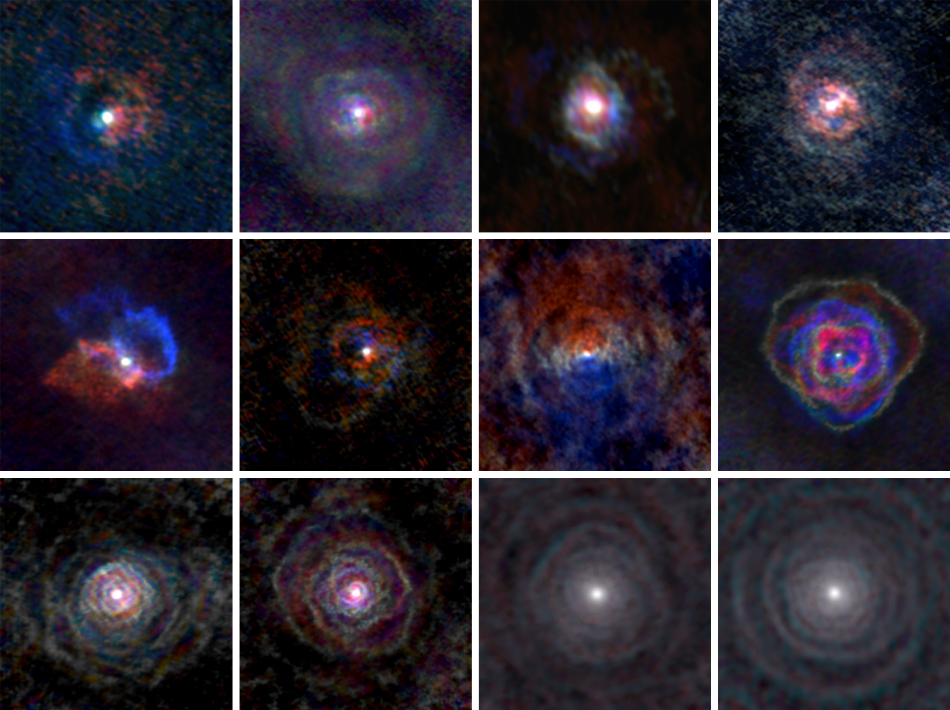Sep 18 2020
Astronomers have now provided an explanation for the spellbinding shapes of planetary nebulae. The finding is based on an incredible set of observations of stellar winds around ageing stars.
 This image gallery of stellar winds around cool ageing stars shows a variety of morphologies, including disks, cones, and spirals. The blue color represents material that is coming toward you; red is material that is moving away from you. Image Credit: © L. Decin, ESO/ALMA.
This image gallery of stellar winds around cool ageing stars shows a variety of morphologies, including disks, cones, and spirals. The blue color represents material that is coming toward you; red is material that is moving away from you. Image Credit: © L. Decin, ESO/ALMA.
Contradicting common consensus, astronomers have discovered that stellar winds are not spherical but instead have a shape comparable to that of planetary nebulae.
They concluded that interaction with an exoplanet or associated star molds the stellar winds as well as the planetary nebulae. The results were reported in the Science journal.
Dying stars normally swell and cool to finally turn into red giants. They create stellar winds, which are flows of particles expelled by the star, and this makes them to lose mass. Since comprehensive observations were missing, astronomers have always believed that these stellar winds were spherical, similar to the stars surrounded by them. As the star evolves more, it heats up again and the stellar radiation makes the expanding ejected layers of stellar material to glow, creating a planetary nebula.
For epochs, astronomers were unaware about the unusual variety of colorful shapes of planetary nebulae that had been detected. It seems as though the nebulae have a specific symmetry but are virtually never round.
The Sun—which will ultimately become a red giant—is as round as a billiard ball, so we wondered: how can such a star produce all these different shapes?
Leen Decin, Study Corresponding Author and Professor, KU Leuven
Decin’s team noticed stellar winds surrounding cool red massive stars with the ALMA observatory based in Chile, the world’s largest radio telescope. For the first time ever, the team gathered a large, comprehensive collection of observations, and each of them was made using the exact same approach. This was vital to be able to immediately compare the data and reject biases.
However, the astronomers were surprised by what they saw. “We noticed these winds are anything but symmetrical or round,” added Professor Decin. “Some of them are actually quite similar in shape to planetary nebulae.”
Companions
The team could even detect various sets of shapes. “Some stellar winds were disk-shaped, others contained spirals, and in a third group, we identified cones.” This is a strong indication that the shapes were not produced haphazardly.
The astronomers understood that the different patterns are being caused by other, low-mass stars or even heavy planets in the surrounding area of the dying star. These companions are very tiny and dim to detect instantly.
“Just like how a spoon that you stir in a cup of coffee with some milk can create a spiral pattern, the companion sucks material towards it as it revolves around the star and shapes the stellar wind,” explained Decin.
The astronomers applied this theory into models, and certainly the shape of the stellar winds can be described by the companions surrounding them, and the speed at which the cool evolved star is losing its mass because the stellar wind is a significant parameter.
Decin added, “All our observations can be explained by the fact that the stars have a companion.”
To date, calculations regarding the evolution of stars were founded on the belief that aging Sun-like stars contain spherical stellar winds.
“Our findings change a lot. Since the complexity of stellar winds was not accounted for in the past, any previous mass-loss rate estimate of old stars could be wrong by up to a factor of 10,” added Decin.
The researchers are currently doing additional research to see how this might influence calculations of other major characteristics of galactic and stellar evolution.
The Future of the Sun
The research also helps to imagine what the Sun might resemble when it dies in 7000 million years.
Jupiter or even Saturn—because they have such a big mass—are going to influence whether the Sun spends its last millennia at the heart of a spiral, a butterfly, or any of the other entrancing shapes we see in planetary nebulae today. Our calculations now indicate that a weak spiral will form in the stellar wind of the old dying Sun.
Leen Decin, Study Corresponding Author and Professor, KU Leuven
“We were very excited when we explored the first images,” stated co-author Miguel Montargès from KU Leuven. “Each star, which was only a number before, became an individual by itself. Now, to us, they have their own identity. This is the magic of having high-precision observations: stars are no longer just points anymore.”
The research is part of the ATOMIUM project, which intends to learn more about the chemistry and physics of old stars.
Cool ageing stars are considered to be boring, old and simple, but we now prove that they are not: they tell the story of what comes after. It took us some time to realise that stellar winds can have the shape of rose petals (see, for example, the stellar wind of R Aquilae), but, as Antoine de Saint-Exupéry said in his book Le Petit Prince: ‘C’est le temps que tu as perdu pour ta rose, qui fait ta rose si importante’—‘It’s the time you spent on your rose that makes your rose so important’.
Leen Decin, Study Corresponding Author and Professor, KU Leuven
Journal Reference:
Decin, L., et al. (2020) (Sub) stellar companions shape the winds of evolved stars. Science. doi.org/10.1126/science.abb1229.